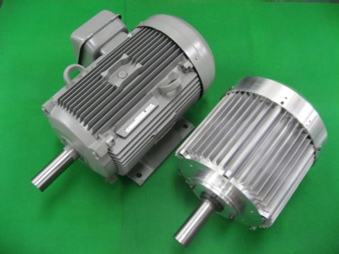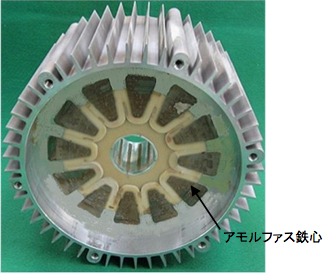Apr
16
High Efficiency Electric Motor Freed of Rare Earth Elements
April 16, 2012 | 4 Comments
Both U.S. and Japanese news services have picked up the announcement that Hitachi has developed a high-efficiency 11 kW (About 14.75 hpe) permanent magnet synchronous motor without using the rare earths neodymium and dysprosium.
The announcement has the new 11 kW motor’s efficiency rated at about 93% and running at the highest of the International Efficiency classes, IE4 Super Premium Efficiency performance. The motor is even smaller than a conventional motor of comparable size.
Japan has been deeply affected by the short-lived Chinese embargo of rare earth elements and the export restrictions that continue to this day. That event set off an increased rush of research in magnets freed from using the heretofore-common neodymium (Nd-Fe-B) magnet.
The new Hitachi and Hitachi Industrial Equipment Systems joint project motor is designed to work at industrial jobs such as running large fans for sending air and operating fluid pumps.
The new 11 kW double-rotor, axial-gap motor uses a laminated stator core based on a low-loss amorphous iron material. Hitachi says that the losses from its laminated material are about 10% of those of conventional electromagnetic steel laminations.
An amorphous metal has a disordered atomic structure versus the crystalline structure of conventional metals, and features a high tensile strength and extremely low magnetic losses. As such, it has been a target of interest for motor development for decades. Its adoption, however, has been hampered by the cost of manufacturing. Hitachi says it’s an issue they’re addressing.
Compared with magnetic steel sheets, which are commonly used to build rotors, the amorphous metal has about 10 times higher magnetic permeability, and its energy loss (iron loss) as a magnetic material is about 1/10th, making it easy to improve motor efficiency.
The structure of the motor employs an “axial gap method” that uses two rotors to sandwich a stator in the direction of the axis of rotation in the aim of increasing the amount of ferrite magnet used for the motor.
In the structure of the iron core, the firms changed the method of processing the amorphous metal. The amorphous metal is as thin as 25μm and has a higher strength than a magnetic steel sheet.
In the past, they used the “rolled iron core structure,” which forms an iron core by rolling the amorphous metal without cutting it. With this method, however, a remaining stress is generated inside the material by bending it, increasing iron loss. But this time they’ve developed a technology to cut the amorphous metal and employed the “laminated iron core structure,” which laminates the metal. As a result, they prevented iron loss from being increased by the process.
The firms have also made improvements to the structures of the motor to increase the output power and efficiency of the motor. They improved the motor’s resistance to torque reaction force by increasing output power by using a resin with fracture toughness is as high as 3.1MPa√m for the stator. And they changed the structure of the rotor so that it can withstand high centrifugal forces.
Hitachi has been working at developments since at least 2008 when they announced an 86% efficient motor that was 5% more efficient that the contemporary motors using rare earth magnets.
Hitachi used 3D magnetic field analysis software to analyze the various characteristics of the core laminations to optimize the efficiency of the laminated design.
This is all great news for the electric motor field. Just keep in mind that the design of a motor needs to match the use, and there are several basic designs in use today. The Hitachi design here is for low starting torque – not something your anticipated electric vehicle can use. Still the Hitachi motor application class is huge and much of the material developments can transfer to other designs.
The most encouraging portion is the prospect of mass-produced amorphous metal production – something a firm like Hitachi can be expected to accomplish. Once that threshold is achieved the amorphous magnet market might get quite a bit bigger very quickly.
Comments
4 Comments so far





[…] High Efficiency Electric Motor Freed of Rare Earth Elements Posted on New Energy and Fuel about Hitachi’s development of a high efficiency motor that does require rare earths elements which is great breakthrough for electric motors. […]
Hysteria about “shortages” of “critical” commodities almost always assumes man stands idle. When money is to be made, man never stand idle.
Really enjoyed this blog article.Really looking forward to read more. Cool
Good day! I could have sworn I’ve visited this web site before but after going through a
few of the articles I realized it’s new to me. Anyways, I’m definitely pleased I
came across it and I’ll be bookmarking it and checking back often!